Dialogue with the Chief Lumada Business Officer
Nikkei Business Online Edition: October 2021 Special Feature

For many years, Hitachi, Ltd. (hereinafter Hitachi) has been providing the systems that support social infrastructure, including infrastructure for electric power, railways, telecommunications, and water and sewer services. Hitachi promotes its social innovation business through the high-level fusion of digital technologies with the knowledge and expertise it has cultivated in various businesses. By resolving social issues and business management issues, Hitachi aims to achieve sustainable growth. Playing an important role in this effort is Lumada: a collection of solutions, services, and technologies that utilize Hitachi’s cutting-edge digital technologies to collaboratively create new value. Social Infrastructure Systems Business Unit CLBO & COO Yoshinori Hosoya talked with Hitachi newcomers Yoshimitsu Kaji and Madoka Sawa about the overall vision of this effort and about Lumada.
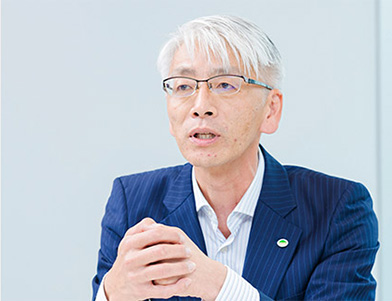
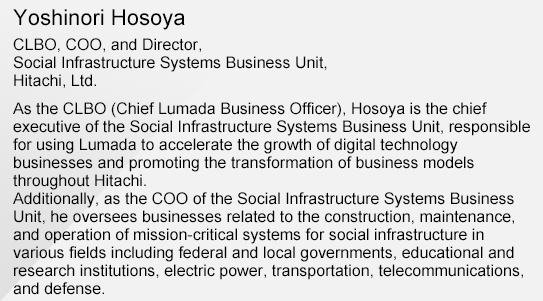
―What are some case examples of the digital transformation of social infrastructure?
Hosoya: As the first example, let’s take a look at one of the main businesses of the Social Infrastructure Systems Business Unit, namely the maintenance of social infrastructure.
Right now, Japan is facing a serious problem where social infrastructure, such as water and sewage pipes, gas pipes, telecommunication lines, and power lines, continues to age. At the same time, there is a shortage of experienced technicians who maintain this infrastructure and the average age of these technicians is on the rise.
To address this problem, Hitachi has developed a mechanism that uses sensors and drones to achieve continuous monitoring and detect failures, thereby automating and optimizing work related to infrastructure inspections. The use of this solution under normal circumstances allows failures to be discovered at an early stage, supporting the stable management of social infrastructure in a way that does not depend on the skills of experienced technicians. Furthermore, in the event of a large-scale disaster, the solution makes it possible to swiftly ascertain damage to social infrastructure without having to send technicians into hazardous areas, thus contributing to rapid recovery and, subsequently, national resilience (as shown in the figure).
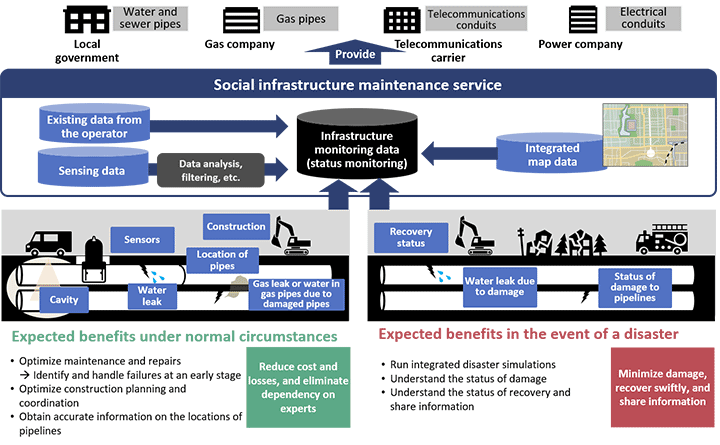
Figure: A social infrastructure maintenance service that uses Lumada
Regarding the maintenance of social infrastructure, due to aging equipment and the shrinking pool of maintenance workers, it is becoming harder and harder to maintain the same levels of service as before. To address this challenge, we have created a new maintenance and management service that balances service levels and cost. This service is centered on a platform of digitalized field data and work expertise.
Before implementing these mechanisms on a broad scale, we conducted a PoC (proof of concept) of our water-leakage detection service. The PoC was conducted in Kumamoto, which had suffered a citywide water outage and other extensive damage following the 2016 Kumamoto earthquakes.
This service used Hitachi’s proprietary ultra-sensitive vibration sensors to identify areas of leakage along water pipes both quickly and with high accuracy. Traditionally, inspecting for water leaks required an expert inspector to walk around the city and physically inspect the water pipes. It was a daunting task, but with this service, the city could quickly and reliably maintain and manage its aging water pipes even with a shortage of experienced inspectors.
Actually, these ultra-sensitive vibration sensors were originally made for some other purpose, but through Lumada, we were able to put the same sensors to use for another purpose, specifically the detection of water leaks. Furthermore, this service sends the information gathered from sensors to servers in a remote location, so under the Lumada system, we are collaborating with a telecommunications carrier to develop technology that that ensures the stable and economical use of mobile networks at all times.

Kaji: Unfortunately, large-scale disasters are expected to increase exponentially both in scope and frequency. I think it’s fair to say that only Hitachi is capable of handling a service that does not simply replace individualized tasks with a high-precision mechanism, but also protects social infrastructure from large-scale disasters and facilitates early recovery.
Sawa: Just now, Mr. Hosoya mentioned repurposing technology to create a new service. I think this is a very important point because, in an emergency, having a mindset of “Our expertise can be applied to other areas—let’s give it a shot!” as well as an internal organizational structure and framework that can mobilize immediately will be of the greatest help.
With the integration of OT (control and operational technology) and IT in recent years, the number of cyberattacks on social infrastructure has increased dramatically. Attack methods are getting more ingenious by the day, so there is no perfect way to protect infrastructure from attacks. To maintain a defensive stance with the assumption that an incident is bound to occur, it is important to form an organizational structure that has the diverse expertise needed to flexibly formulate and execute the best response in every situation. In that respect, Hitachi can securely carry out maintenance in both the real and the digital realms and use Lumada to swiftly combine a wealth of knowledge. Going forward, this will be very significant.
Hosoya: I have another example of the digital transformation of social infrastructure. Hitachi is currently working with an electric power company and other business partners on a co-creation project with the aim of contributing to the stable provision of electric power and the widespread use of renewable energy.
For example, we provided a solution that determines, in real time, how to control power transmission systems to ensure the stable provision of electricity. In the event of a transmission system failure, this solution effectively uses the remaining transmission-capacity margin power of the power lines of existing transmission systems. With this solution, we can determine the amount of power generated by each system and control the systems to achieve an overall balance. We think this will be effective in stabilizing power systems where renewable energy such as wind power generation has been introduced.
In addition, when introducing wind power generation, sometimes it is necessary to renovate or enhance facilities because the transmission system does not have enough transmission-capacity margin power. In such cases, if we apply this solution, we can cut down the massive amount of time and money needed to repair facilities and look forward to the spread of renewable energy that effectively uses existing facilities.
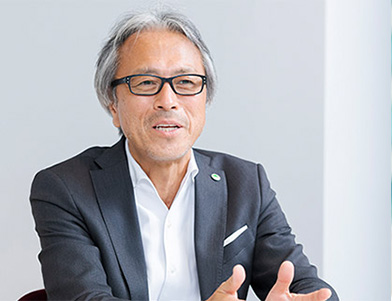
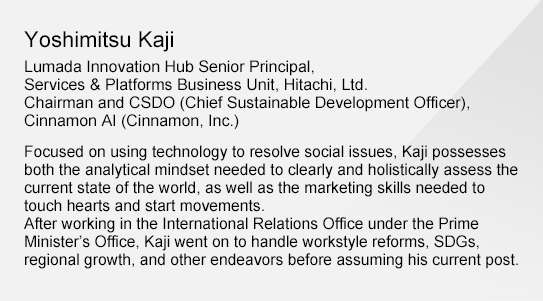
―Especially in the case of businesses that support social infrastructure, I think there are various challenges when it comes to digital transformation. Can you tell us about some specific hurdles and the key to overcoming those hurdles?
Hosoya: For digital transformation, most projects will involve many companies and groups. As such, there will be many stakeholders, so the first step is to convince the stakeholders of the value of digital transformation. That being said, a lot of stakeholders don’t really know what digital transformation entails, so we have to start by first clarifying the goal or ideal to be achieved and then come up with an idea for how to achieve that goal or ideal. Then, to implement the idea, we connect customers with other customers, hone our technologies, and engage in mutually beneficial co-creation through which new value is created.
Hitachi is involved in the development of new materials and, as a concrete example, I’ll talk about digital transformation within that context.
The development of new materials is both a source of a company’s competitive strength and essential to creating a sustainable society through high-performance materials. Thus, what we need more than anything is fast research and development.
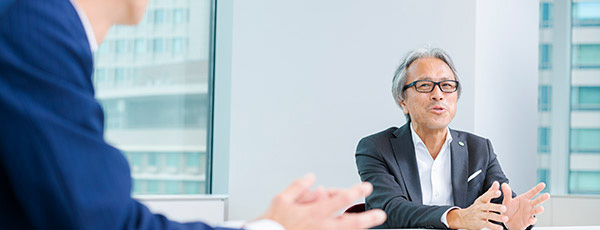
To that end, Hitachi provides a solution that analyzes data from simulations and experiments to quickly and efficiently discover features and other information about materials. This solution can substitute for the experiments and simulations that, until now, relied heavily on the experience of experts.
In addition to our independently developed AI and data analysis environment, we also provide a service whereby Hitachi data scientists help customers analyze data about materials so that customers can develop materials more efficiently. By fusing the customer’s material development specialists and Hitachi’s digital technologies, we can not only reduce the time and cost needed to develop materials, but also lessen the impact of development on the environment. Accelerating the development of recycled materials and high-performance materials is directly connected to building a recycling-oriented society, so Hitachi is pushing forward with co-creation projects with Teijin, Mitsui Chemicals, Toyota Motor, and other customers.
Sawa: One of the challenges when it comes to digital transformation is the fact that, oftentimes, the executives who hold the purse strings do not have a sufficient understanding of IT.
That’s why we see cases where executives are satisfied with just conducting a bunch of PoCs and don’t really try to move on to the next step. Furthermore, a Japanese company often doesn’t want to bear any liability if a PoC fails. As a result, vendors often shoulder the costs of the PoC and thus work on a tight budget. In such situations, the Japanese company doesn’t invest serious effort into the project and just ends up in a PoC loop. In contrast, outside of Japan, a large majority of companies conduct PoCs as part of larger projects right from the outset, and responsibility usually lies with their own stakeholders. This is a decisive difference between Japan and the rest of the world. Accounting for this difference, how can we make stakeholders get serious and convince them to pursue digital transformation? I think that will be a major challenge.
Kaji: In the future, co-creation that transcends the boundaries of businesses and industries will become key. When that happens, linking OT and IT will be important, but Hitachi already has an organizational structure that makes it easy for different business divisions within the company to collaborate. We don’t just collaborate with other groups in our own company, but we also join forces with other companies, and clearly distinguish between areas of competition and areas of cooperation. By using Lumada and combining our strengths with those of our business partners, we have now changed course to focus our energy on co-creation.
That’s why we started the Lumada Alliance Program, which we touched on previously. This program allows Hitachi and our business partners to use each other’s technologies, knowledge, and ideas. Similarly, we opened Lumada Innovation Hub Tokyo, a new site for combining knowledge. Through this hub, our business partners can connect, both in a real sense and in a virtual sense, to Hitachi facilities and human resources on the front lines of digital transformation, including our research and development sites Kyōsō-no-Mori and Omika Works.
The fact that Hitachi, which is active in many business fields, has decided in earnest to leverage OT and IT to resolve social infrastructure issues—I think that is a huge deal.
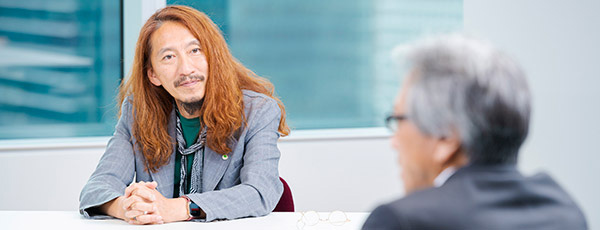
Hosoya: Exactly. Hitachi has been actively developing and providing mechanisms that allow us to engage in digital transformation with our customers. For example, NEXPERIENCE is our co-creation methodology whereby we collaborate with customers to launch new businesses and services. NEXPERIENCE has been put to real use several hundred times both in Japan and around the world.
In addition to the programs and sites that Mr. Kaji mentioned just now, we have launched a sharing platform called the Lumada Solution Hub. This platform stores proven solutions developed by Hitachi and our partners in various industries and for different companies. With the Lumada Solution Hub, you can find what you need, quickly and with pinpoint precision.
Going forward, we can no longer resolve issues or create value as a single company or a single industry. Instead of emphasizing self-sufficiency and trying to resolve issues by using our own technologies and solutions, I plan to continue working with our business partners and enhancing mechanisms to accelerate co-creation.
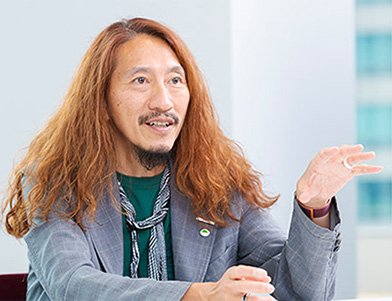
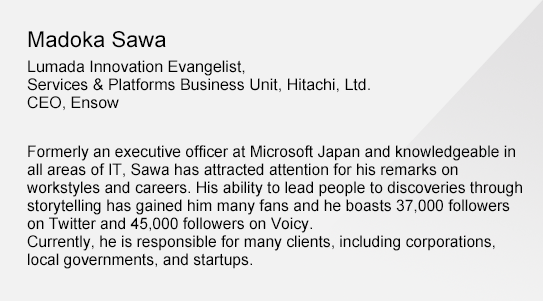
―Going forward, how will Hitachi facilitate the digital transformation of social infrastructure? And what kind of society does Hitachi want to create through these efforts?
Hosoya: For example, electricity and weather and trains, roads and underground equipment, the security of buildings and important facilities—because these are all connected, we should be able to create a safe and secure society and improve people’s quality of life.
An example of something we want to create is a service that visualizes all objects below the surface. This would allow us to accurately ascertain things such as underground water pipes and gas pipes. If we could provide this service to society, tasks such as managing water supply, gas, electricity, and other infrastructure or applying to the local government for a construction permit could all be done digitally. Furthermore, if we linked the service to construction machinery or other work machines, we’d be able to automatically control things like how far we can dig in a particular location. That would mean that construction could be carried out quickly and without relying on experienced engineers or operators, helping to reduce impact on the environment and accelerate post-disaster recovery, which in turn contributes to national resilience.
Currently, we have only achieved partial optimization. For full optimization, we hope to create a mechanism that connects not only Hitachi, but also customers and business partners in various fields, and to achieve “social infrastructure as a service” that connects data across company, industry, and national borders.